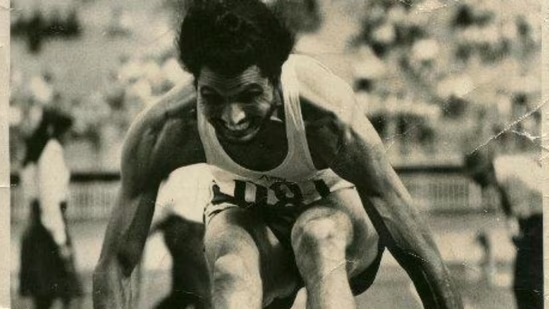For Gill, the triple jump 1-2 had a special touch
It's well past midnight in California, but Mohinder Singh Gill is unstoppable. Memories keep rushing back, each strand unlocking a fresh, forgotten chest of reverie. All it needed was a trigger, and the pathbreaking one-two by Indian triple jumpers Eldhose Paul and Abdulla Aboobacker at the recently-concluded Commonwealth Games (CWG) in Birmingham provided just that.  PREMIUM
PREMIUM
"I am really happy with the performance of our jumpers. All credit goes to them and their coaches. An Indian athlete typically fights the system because he/she fights the field, and I understand how special this is for both of them" he said.
Gill would know. Having courted success twice at CWG — he won a bronze in Edinburgh in 1970 and followed it up with a silver four years later in Christchurch — he remains the earliest torchbearer of triple jump in the country.
The 75-year-old could only catch the recorded videos of Paul and Aboobacker's performance, and the two-time Asian Games medallist couldn't help but marvel at the technical changes the sport has undergone over the years.
"The first thing I noticed was their technique. Technically, all three Indian boys (Praveen Chitravel was the other Indian in the final) were very good. In my time, I was all power and no technique, because nobody taught me the latter. So, I lifted weights and became strong, and expended everything I had on my jumps. Only very late in my career did I realise that the triple jump is a very technical sport," he said.
A combination of three stages — hop, skip, and jump — the triple jump is an examination of an athlete's explosive power and the ability to efficiently transfer the kinetic energy through the act. Gill noted an appreciable change in the hop landing and final steps on the runway, both of which have become swifter and shorter.
"When I saw the Indian boys using short steps towards the end of the runway, I was really happy because I used to do the opposite. Longer steps before the takeoff give more height, while shorter steps add momentum and distance. The modern approach also saves strength," he explained.
What Gill lacked in technique, he made up with strength. He would climb the stadium steps with weights upwards of 300 pounds, and deadlift over 550 pounds to build his leg and core muscles, the key muscle groups that generate explosive power.
"Technology is so advanced these days, which is wonderful for athletes. They know precisely how to train, and they have access to the right technique. I was not surprised that all these boys have now jumped over 17 metres. They should all build from here."
"Key to any good performance at the international level is training and exposure. We must ensure these youngsters be given as much international exposure as possible, as it will not only build their confidence but help them grow as individuals. As Indians, we are conditioned to stress over everything. I have seen American athletes dancing a day before their events and then producing a great result the next day. Your mind must be completely relaxed for your body to deliver peak performance at crunch moments," Gill continued.
The big change
The accrued wisdom is a far cry from his active athletic years, a major chunk of which was spent taking on what was then the Amateur Athletics Federation of India. It's been over four decades since Gill hung his spikes and became a successful entrepreneur, but he still carries a fair degree of bitterness.
"There are endless stories about the federation at the time. Corruption and favouritism were rampant. On more than one occasion, I was not sent flight tickets on time because the officials didn't want me to compete. At international meets, athletes would stay on $2 a day but officials would shop for their families. It was quite depressing," he recalled.
The tipping point was reached in the late-60s when his national record was not recognised twice. "The then president and secretary of the federation were from Railways, and they wanted me to join them. When I refused, they didn't ratify my national record twice. That left me really hopeless."
Gill's moment of epiphany arrived when he had a chance meeting with Tommie Smith at the World University Games in Tokyo in 1967. The sprinter sat through Gill's talk and advised him to apply for scholarships at US universities. Their lives would change in divergent ways next year; while Smith won the 200m sprint at Mexico Olympics and did the iconic Black Power salute on the podium, Gill landed scholarships from six US varsities. He picked California Polytechnic State University.
"The moment I landed here, I was pleasantly surprised by the lack of corruption. The facilities were not what they are now, but they respected athletes, unlike in India," he said.
Gill would win five NCAA titles, each with a meet record. He was even offered US citizenship, but the proud Sikh refused. "I still had the fire to win an Olympics medal for India."
He arrived in Munich in 1972 having won consecutive Pre Olympics meets, but a hamstring tear during a practice leap three days before his event sent him out of the Games.
"I knew that was my best chance. I was in the zone, really confident. I was sad, depressed, and distraught. I went to London with a few friends and drank the pain away. It still stings," he rued.
"Things have changed a lot now. Elite athletes largely get the guidance they need, so we should expect them to deliver. What Paul and Aboobacker have achieved will stay with them till the end of their lives. Chitravel should not be disheartened either. I believe he has the game and technique to do much better. As a former jumper, I feel extremely proud of these kids," Gill concluded.
Experience unrestricted digital access with HT Premium
Explore amazing offers on HT + Economist Start 14 Days Free Trial Already Subscribed? Sign In
Disclaimer: The copyright of this article belongs to the original author. Reposting this article is solely for the purpose of information dissemination and does not constitute any investment advice. If there is any infringement, please contact us immediately. We will make corrections or deletions as necessary. Thank you.







